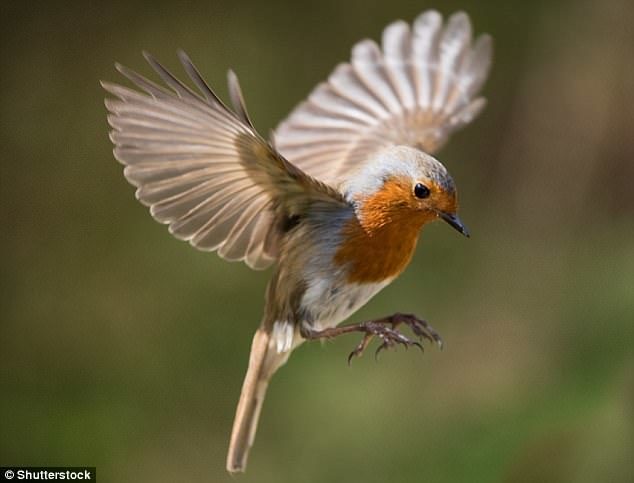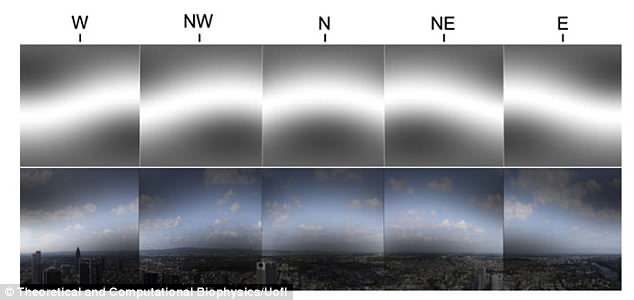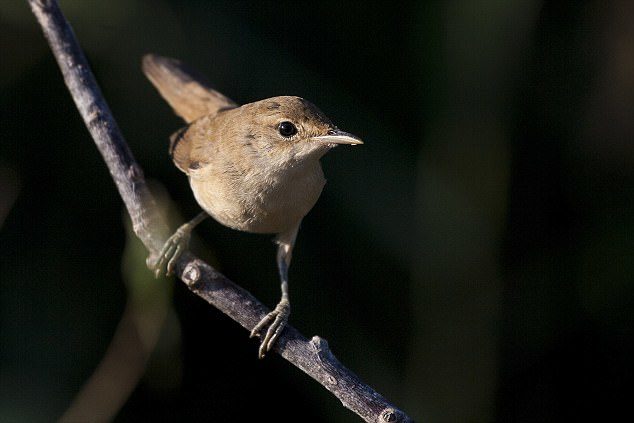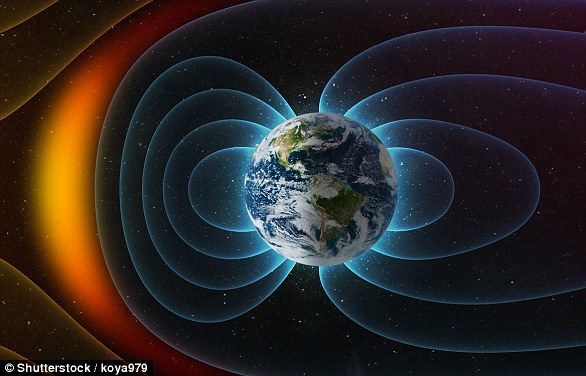
Now researchers have found the secret to this skill is down to a protein in the bird's eyes that is sensitive to blue light.
This protein lets them 'see' Earth's magnetic field as an overlay on their normal field of view, two studies suggest.
Scientists from Lund University in Sweden looked at zebra finches, while researchers from Carl von Ossietzky University Oldenburg in Germany studied European robins.
For a bird to know roughly where it is in the world, and correct itself if it goes off course, it needs what is known as 'true navigation'.
They do this by using the magnetic field to plot their migratory routes.
Scientists believe the Earth's core is responsible for creating its magnetic field.
As molten iron in the Earth's outer core escapes it creates convection currents. These currents generate electric currents which create the magnetic field.
Experts knew that birds could only sense magnetic fields if certain wavelengths of light were available, but they did not know why this was the case.
According to researchers a protein called Cry4, which is present 24 hours a day and means birds can still navigate during night, is responsible for this.
They found zebra finches had three cryptochromes - Cry1, Cry2 and Cry4 - in the brains, muscles and eyes, writes Science Alert.
Cryptochromes are sensitive to blue light, which have wavelengths between 400 and 495 nanometres.

Researchers found levels of Cry1 and Cry2 varied in zebra finches studied but levels of Cry4 remained constant.
'We also found that Cry1a, Cry1b, and Cry2 mRNA display robust circadian oscillation patterns, whereas Cry4 shows only a weak circadian oscillation', researchers, led by Dr Atticus Pinzon-Rodriguez from the University of Lund, wrote in the study.
'We assume that birds have microscopic compasses and they use them any time of day or night,' added co-author Rachel Muheim from the University of Lund.
This finding was supported by the team looking at robins, which found the same thing.
They also found European robins had increased Cry4 expression during the migratory season.

The study on the zebra finch was published in the Journal of the Royal Society Interface while the robin study was published in Current Biology.
Last year, researchers did a similar study looking at bird navigation with Eurasian Reed Warblers.
They found reed warblers use a neat trick to navigate - by somehow measuring the variation between true north, and magnetic north.

While a compass needle points to the magnetic north, this is not the true north - the North Pole.
Depending on where you are, magnetic north is either one or more degrees further east or west of the north pole.
By taking into account the difference between the magnetic north and true north, the reed warbler is able to sense how far west or east it is.
The scientists have shown the reed warbler, can sense this difference - known as declination - and use the information to plot its longitudinal point on Earth.
The way reed warblers do it remains a mystery, but the birds can use declination to work out their equivalent of longitude, the researchers found.
It is not known if they also use the Cry4 protein.
The findings were reported in the journal Current Biology.
WHAT IS THE EARTH'S MAGNETIC FIELD AND HOW DO BIRDS USE IT?
Scientists believe the Earth's core is responsible for creating its magnetic field which is a force created by moving electrical charges.
As molten iron in the Earth's outer core escapes it creates convection currents. These currents generate electric currents which create the magnetic field.
This is a natural process known as a geodynamo.
This creates a geomagnetic field that extends from the interior of the Earth to where it meets the solar wind, which is charged particles coming from the sun.
Birds use this magnetic field to plot their migratory routes. This has often been called their 'sixth sense'.
For a bird to know roughly where it is in the world - and correct itself if it goes off course - it needs what is known as 'true navigation'.
This means it can somehow work out its latitude and longitude.
For humans, the problem of longitude - the co-ordinate that specifies an east-west axis position on the Earth's surface - proved unresolvable until the invention of accurate clocks.The North and South magnetic poles are generally located near the geographic poles. However, they vary over geological time and once every several hundred thousand years they flip.For a bird to know roughly where it is in the world – and correct itself if it goes off course – it needs what is known as 'true navigation'. The Earth's magnetic field (stock image) is pictured
While a compass needle points to the magnetic north, this is not the true north - the North Pole.
Depending on where you are, magnetic north is either one or more degrees further east or west of the north pole.
New research suggests birds rely on a protein in their eyes that means they can 'see' Earth's magnetic field and this stream of charged particles.
Scientists from Lund University in Sweden looked at zebra finches, while researchers from Carl von Ossietzky University Oldenburg in Germany studied European robins.
According to researchers a protein called Cry4, which is present 24 hours a day and means birds can still navigate during night, is responsible for this.
This means they can 'see' these magnetic fields over their normal vision.
Researchers also found European robins had increased Cry4 expression during the migratory season.




Reader Comments
Meaning they also need to have inbuilt Starmaps to use as celestial navigation.. Seriously??